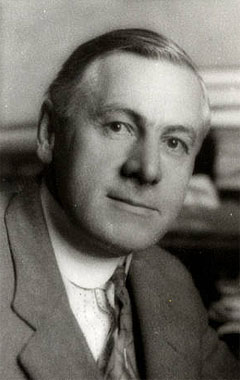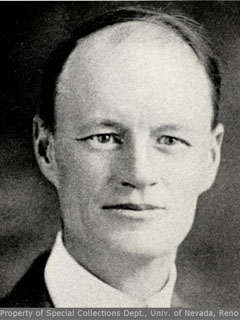Located on the east bank of Manzanita Lake is a semi-circular concrete bench on a concrete patio, along with a bird bath. There's a bronze plaque imbedded in the patio that reads:

Dr. Charles E. Haseman, known to his students as 'Prof Charlie', was the head of the Mathematics Department for many years. He also formed the campus Glee Club in 1911 and wrote a number of songs for a published song book in 1927 titled
Songs of the University of Nevada by the Associated Students of the University of Nevada that included songs such as "Nevada, My Nevada", Hail Sturdy Men", and "Daughters of Thine, W.A.A.". He also co-composed "Ode to Nevada". I was able to locate an online obituary for Dr. Haseman and his wife, Lucile,
here. They are both buried in Mountain View Cemetery in Reno, NV. Dr. Haseman lived from 1880 to 1931.
Dr. J. Claude Jones was a geography professor at the University of Nevada and I was able to locate an online obituary of his untimely death in 1932 due to a blood clot after recuperating from a major surgery. It reads:
In the death of Dr. J. Claude Jones on March 2, 1932, the University of Nevada lost one of the best beloved and most outstanding members of its faculty and the geologic profession an earnest worker of great enthusiasm for the advancement of knowledge. An old injury received in a game of soccer football, to which he was devoted when he went to the University of Nevada more than twenty years ago, brought on new trouble and necessitated a major
operation. This apparently gave relief and he was showing rapid improvement when a clot in the blood stream unexpectedly proved fatal. Most lamentably he was thus stricken in his prime when, as the new dean of men, his value to the University and the community was greatest, and when richest fruits were to be expected from his broad familiarity with the geology of Nevada, acquired through many years of patient work.

J. Claude Jones was born on July 2, 1877, at Merrimac, Wisconsin, where he lived till eleven years old. The family moving to Chicago, he attended the Chicago Manual Training School, the first high school of its kind, and later entered the University of Illinois, graduating in 1902. From 1904 to. 1906 he served the State University as assistant and instructor in geology and in 1906- 1909 pursued graduate studies at the University of Chicago, spending the summers
in field work for the Illinois Geological Survey. During these formative days at Chicago Jones was the recognized leader in the activities of the graduate students of the geological department, presiding at their meetings, toastmaster when such was needed, and universally liked for sterling personal qualities, contagious optimism, and general helpfulness. Later he received the degree of Ph. D. In 1909 he went to the University of Nevada as instructor in geology and mineralogy and was advanced to assistant professorship the following year. Full professorship and headship of the department in the Mackay School of Mines came in 1914.
Dr. Jones' scientific contributions were largely on the geology of Nevada. From careful studies of the tufa deposits of Lake Lahontan he concluded that this great lake had its beginning only 2,000-4,000 years ago and reached its greatest extent and depth only about 1,000 years ago. This was startling to not a few geologists in view of the fact that many of the large animals whose remains are found in these lake sediments are extinct or no longer live in the region. But he maintained his position against opposition, and more recent finds elsewhere by vertebrate paleontologists are now pointing strongly to the conclusion that many of the mammals no longer living in our western states continued to exist there much longer than formerly supposed, thus supporting Jones' contentions.
His studies on the origin of the tufa deposits in Pyramid Lake and the
Salton Sea, as well as the origin of the oolites, were important contributions.